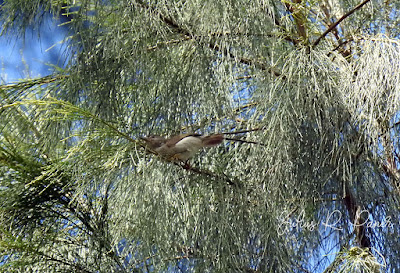The entire Mt. Apo Natural Park is
a huge protected area covering two provinces and two big cities. Geographically
it is never easy to identify a good site for birding despite it being an abode
of several endemic and resident birds. As a newbie in birding I have yet to
personally see majority of Mindanao endemic birds here, particularly popular
species which according to some could be seen effortlessly such as the Apo Myna
and Philippine Eagle.
The latest information I got from
Pete Simpson is all about the Mindanao Miniature Babbler (MMB), another
Mindanao endemic which according to him can be best seen in Lake Agco of
Kidapawan City. Lake Agco is a jump off point to Mt. Apo which happened to be
another common entry point in North Cotabato area but is temporarily closed as
of the moment due the series of earthquakes happening in Mindanao over the last
4 months. The Mindanao Miniature Babbler was the ultimate reason why I was
enticed to join Pete’s birding session with guests from United Kingdom last
January 12.
Right after they chased the
Japanese Night Heron at Eden Resort Pete’s group picked me up at Sta. Cruz and
we travelled all the way to Kidapawan City. This session was made with a prior
consent from Tourism Office Joey Recimilla and staff Ver Sibonga. Our entry through
Agco was welcomed by remnants of earthquake with people being placed in a
specific evacuation center in between the city and the lake. The entire sitio
is like a ghost town and I thought it would take some more time before they
could go back to their residents.
Right up the intersection to Agco
Resort we started our birding hoping to immediately see the Mindanao Miniature
Babbler in a shade of some common pine trees. No one seen right there though,
but some familiar birds came like Brahminy Kite, Philippine Bulbul and Grey
Wagtail. We thought of just staying outside as initially relayed by Pete but
with Ver joining us we were allowed to get inside the resort, perhaps a much
better idea because there are a lot more birds there.
Near the entrance waiting for us
was one Philippine Serpent Eagle, an endemic raptor in the Philippines perching
in a very favorable perspective, the first time I caught with a lens this
attractive species we always failed to photograph with my Big Year Team.
The policy to not allow people to
enter the resort was a blessing in disguise for us. Silence always allow birds
to freely room around and in a single location we enjoyed spotting good species
such as Sulphur-billed Nuthatch, Elegant Tit, Mountain White Eye, Long-tailed
Ground Warbler, Bicolored Flowerpecker, Scarlet Minivet and the rare Bundok
Flycatcher which was a lifer to me. From this point we had initial glimpse of
the MMB but there was no clear angle to photograph the bird because aside from
being a hyper one, MMB is also very small to be distinguished from the leaves
and small tree branches.
The closer we got of MMB was at the
façade of the resort where we parked our vehicles. The eager group from UK had
me getting idea to extend patience when doing birding. How could I not wait for
a prestigious species right in my area when in fact people from UK even came
here to see the bird? According to Pete, Lake Agco is the place where he saw
the Mindanao Miniature Babbler in a consistent basis and no other place
elsewhere in Mindanao.
The last spot where Pete brought us
was at a trail going to the hot lake. This beautiful area is decorated not only
with good vegetation but some rare species of highland birds, most notable are
the Buzzing Flowerpecker, Little Pied Flycatche, Turquoise Flycatcher and
Orange-bellied Flowerpecker. For sure there are other stuffs that Pete said he
saw but I never had good glimpse which is another motivation for me to be back
to Lake Agco soon.
The Mt. Apo side of
Kidapawan is for me the most accessible site for birding given that Lake Agco
can now be reached by any type of vehicles. The presence of Mindanao Miniature
Babbler and other Mindanao endemics including the Philippine Eagle has made Lake
Agco a birding hotspot for international birders. At some point this is an unbeaten
opportunity which in the long run can be a good market for ecotourism in the
place other than trekking and mountaineering. On a contrasting surface this is
a challenge to all of us especially the local and national government agencies.
The fact that birds are dependent on our forest cover should always keep us
keen on how to make them stay and multiply.
















No comments:
Post a Comment